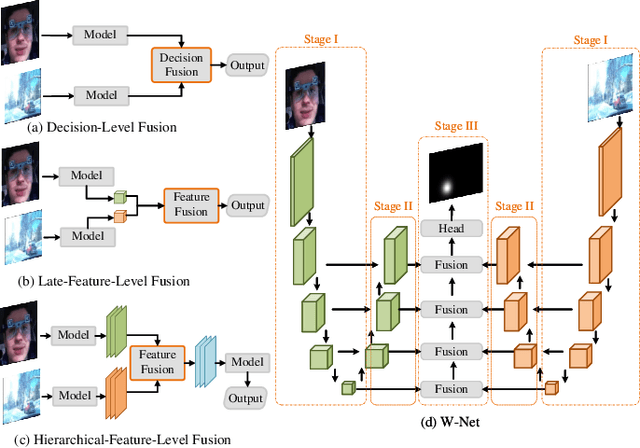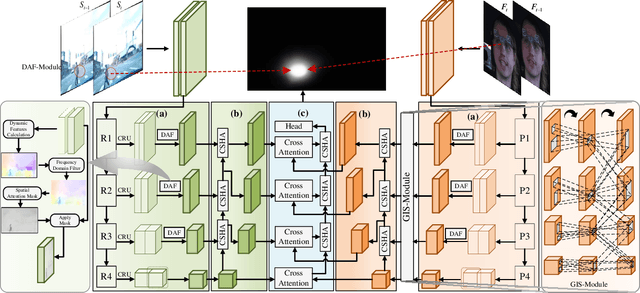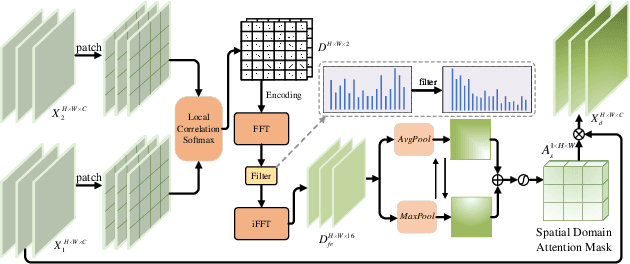Zhiqiang Yang
When Deepfakes Look Real: Detecting AI-Generated Faces with Unlabeled Data due to Annotation Challenges
Aug 12, 2025Abstract:Existing deepfake detection methods heavily depend on labeled training data. However, as AI-generated content becomes increasingly realistic, even \textbf{human annotators struggle to distinguish} between deepfakes and authentic images. This makes the labeling process both time-consuming and less reliable. Specifically, there is a growing demand for approaches that can effectively utilize large-scale unlabeled data from online social networks. Unlike typical unsupervised learning tasks, where categories are distinct, AI-generated faces closely mimic real image distributions and share strong similarities, causing performance drop in conventional strategies. In this paper, we introduce the Dual-Path Guidance Network (DPGNet), to tackle two key challenges: (1) bridging the domain gap between faces from different generation models, and (2) utilizing unlabeled image samples. The method features two core modules: text-guided cross-domain alignment, which uses learnable prompts to unify visual and textual embeddings into a domain-invariant feature space, and curriculum-driven pseudo label generation, which dynamically exploit more informative unlabeled samples. To prevent catastrophic forgetting, we also facilitate bridging between domains via cross-domain knowledge distillation. Extensive experiments on \textbf{11 popular datasets}, show that DPGNet outperforms SoTA approaches by \textbf{6.3\%}, highlighting its effectiveness in leveraging unlabeled data to address the annotation challenges posed by the increasing realism of deepfakes.
VisAlgae 2023: A Dataset and Challenge for Algae Detection in Microscopy Images
May 27, 2025Abstract:Microalgae, vital for ecological balance and economic sectors, present challenges in detection due to their diverse sizes and conditions. This paper summarizes the second "Vision Meets Algae" (VisAlgae 2023) Challenge, aiming to enhance high-throughput microalgae cell detection. The challenge, which attracted 369 participating teams, includes a dataset of 1000 images across six classes, featuring microalgae of varying sizes and distinct features. Participants faced tasks such as detecting small targets, handling motion blur, and complex backgrounds. The top 10 methods, outlined here, offer insights into overcoming these challenges and maximizing detection accuracy. This intersection of algae research and computer vision offers promise for ecological understanding and technological advancement. The dataset can be accessed at: https://github.com/juntaoJianggavin/Visalgae2023/.
MHAF-YOLO: Multi-Branch Heterogeneous Auxiliary Fusion YOLO for accurate object detection
Feb 07, 2025Abstract:Due to the effective multi-scale feature fusion capabilities of the Path Aggregation FPN (PAFPN), it has become a widely adopted component in YOLO-based detectors. However, PAFPN struggles to integrate high-level semantic cues with low-level spatial details, limiting its performance in real-world applications, especially with significant scale variations. In this paper, we propose MHAF-YOLO, a novel detection framework featuring a versatile neck design called the Multi-Branch Auxiliary FPN (MAFPN), which consists of two key modules: the Superficial Assisted Fusion (SAF) and Advanced Assisted Fusion (AAF). The SAF bridges the backbone and the neck by fusing shallow features, effectively transferring crucial low-level spatial information with high fidelity. Meanwhile, the AAF integrates multi-scale feature information at deeper neck layers, delivering richer gradient information to the output layer and further enhancing the model learning capacity. To complement MAFPN, we introduce the Global Heterogeneous Flexible Kernel Selection (GHFKS) mechanism and the Reparameterized Heterogeneous Multi-Scale (RepHMS) module to enhance feature fusion. RepHMS is globally integrated into the network, utilizing GHFKS to select larger convolutional kernels for various feature layers, expanding the vertical receptive field and capturing contextual information across spatial hierarchies. Locally, it optimizes convolution by processing both large and small kernels within the same layer, broadening the lateral receptive field and preserving crucial details for detecting smaller targets. The source code of this work is available at: https://github.com/yang0201/MHAF-YOLO.
IAFI-FCOS: Intra- and across-layer feature interaction FCOS model for lesion detection of CT images
Sep 01, 2024Abstract:Effective lesion detection in medical image is not only rely on the features of lesion region,but also deeply relative to the surrounding information.However,most current methods have not fully utilize it.What is more,multi-scale feature fusion mechanism of most traditional detectors are unable to transmit detail information without loss,which makes it hard to detect small and boundary ambiguous lesion in early stage disease.To address the above issues,we propose a novel intra- and across-layer feature interaction FCOS model (IAFI-FCOS) with a multi-scale feature fusion mechanism ICAF-FPN,which is a network structure with intra-layer context augmentation (ICA) block and across-layer feature weighting (AFW) block.Therefore,the traditional FCOS detector is optimized by enriching the feature representation from two perspectives.Specifically,the ICA block utilizes dilated attention to augment the context information in order to capture long-range dependencies between the lesion region and the surrounding.The AFW block utilizes dual-axis attention mechanism and weighting operation to obtain the efficient across-layer interaction features,enhancing the representation of detailed features.Our approach has been extensively experimented on both the private pancreatic lesion dataset and the public DeepLesion dataset,our model achieves SOTA results on the pancreatic lesion dataset.
LSM-YOLO: A Compact and Effective ROI Detector for Medical Detection
Aug 26, 2024Abstract:In existing medical Region of Interest (ROI) detection, there lacks an algorithm that can simultaneously satisfy both real-time performance and accuracy, not meeting the growing demand for automatic detection in medicine. Although the basic YOLO framework ensures real-time detection due to its fast speed, it still faces challenges in maintaining precision concurrently. To alleviate the above problems, we propose a novel model named Lightweight Shunt Matching-YOLO (LSM-YOLO), with Lightweight Adaptive Extraction (LAE) and Multipath Shunt Feature Matching (MSFM). Firstly, by using LAE to refine feature extraction, the model can obtain more contextual information and high-resolution details from multiscale feature maps, thereby extracting detailed features of ROI in medical images while reducing the influence of noise. Secondly, MSFM is utilized to further refine the fusion of high-level semantic features and low-level visual features, enabling better fusion between ROI features and neighboring features, thereby improving the detection rate for better diagnostic assistance. Experimental results demonstrate that LSM-YOLO achieves 48.6% AP on a private dataset of pancreatic tumors, 65.1% AP on the BCCD blood cell detection public dataset, and 73.0% AP on the Br35h brain tumor detection public dataset. Our model achieves state-of-the-art performance with minimal parameter cost on the above three datasets. The source codes are at: https://github.com/VincentYuuuuuu/LSM-YOLO.
EraW-Net: Enhance-Refine-Align W-Net for Scene-Associated Driver Attention Estimation
Aug 16, 2024



Abstract:Associating driver attention with driving scene across two fields of views (FOVs) is a hard cross-domain perception problem, which requires comprehensive consideration of cross-view mapping, dynamic driving scene analysis, and driver status tracking. Previous methods typically focus on a single view or map attention to the scene via estimated gaze, failing to exploit the implicit connection between them. Moreover, simple fusion modules are insufficient for modeling the complex relationships between the two views, making information integration challenging. To address these issues, we propose a novel method for end-to-end scene-associated driver attention estimation, called EraW-Net. This method enhances the most discriminative dynamic cues, refines feature representations, and facilitates semantically aligned cross-domain integration through a W-shaped architecture, termed W-Net. Specifically, a Dynamic Adaptive Filter Module (DAF-Module) is proposed to address the challenges of frequently changing driving environments by extracting vital regions. It suppresses the indiscriminately recorded dynamics and highlights crucial ones by innovative joint frequency-spatial analysis, enhancing the model's ability to parse complex dynamics. Additionally, to track driver states during non-fixed facial poses, we propose a Global Context Sharing Module (GCS-Module) to construct refined feature representations by capturing hierarchical features that adapt to various scales of head and eye movements. Finally, W-Net achieves systematic cross-view information integration through its "Encoding-Independent Partial Decoding-Fusion Decoding" structure, addressing semantic misalignment in heterogeneous data integration. Experiments demonstrate that the proposed method robustly and accurately estimates the mapping of driver attention in scene on large public datasets.
Multi-Branch Auxiliary Fusion YOLO with Re-parameterization Heterogeneous Convolutional for accurate object detection
Jul 05, 2024Abstract:Due to the effective performance of multi-scale feature fusion, Path Aggregation FPN (PAFPN) is widely employed in YOLO detectors. However, it cannot efficiently and adaptively integrate high-level semantic information with low-level spatial information simultaneously. We propose a new model named MAF-YOLO in this paper, which is a novel object detection framework with a versatile neck named Multi-Branch Auxiliary FPN (MAFPN). Within MAFPN, the Superficial Assisted Fusion (SAF) module is designed to combine the output of the backbone with the neck, preserving an optimal level of shallow information to facilitate subsequent learning. Meanwhile, the Advanced Assisted Fusion (AAF) module deeply embedded within the neck conveys a more diverse range of gradient information to the output layer. Furthermore, our proposed Re-parameterized Heterogeneous Efficient Layer Aggregation Network (RepHELAN) module ensures that both the overall model architecture and convolutional design embrace the utilization of heterogeneous large convolution kernels. Therefore, this guarantees the preservation of information related to small targets while simultaneously achieving the multi-scale receptive field. Finally, taking the nano version of MAF-YOLO for example, it can achieve 42.4% AP on COCO with only 3.76M learnable parameters and 10.51G FLOPs, and approximately outperforms YOLOv8n by about 5.1%. The source code of this work is available at: https://github.com/yang-0201/MAF-YOLO.
 Add to Chrome
Add to Chrome Add to Firefox
Add to Firefox Add to Edge
Add to Edge